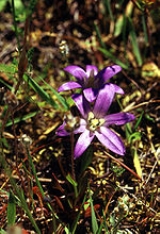
Brodiaea coronaria
Encyclopedia
Brodiaea coronaria is the type species
of Brodiaea
and also known by the common name
crown brodiaea. It is native to western North America from British Columbia
to northern California
, where it grows in mountains and grasslands.
and producing an erect inflorescence
with a few basal leaves. The inflorescence is up to about 25 centimeters tall and bears lilylike flowers on an array of pedicels
.
Each flower is a tube several centimeters long opening into a bell-shaped corolla of six bright purple lobes each up to 3 centimeters long. In the center are three stamen
s and whitish sterile stamens known as staminode
s.
Subspecies
There are two subspecies of this plant. One of them, the Indian Valley brodiaea (Brodiaea coronaria ssp. rosea), is a rare pink-flowered subspecies endemic to a small region in the Inner North Coast Ranges (Tehama, Glenn, and Lake Counties) in northwestern California
.
during the Vancouver Expedition
, and published as Hookera coronaria by Richard Salisbury in his Paradisus Londinensis in 1808. In 1811, James Edward Smith
recognised it as belonging to a separate genus, and segregated it into Brodiaea
as Brodiaea grandiflora. Smith's genus was accepted, but the priority of Salisbury's specific epithet was also recognised, hence the current name.
Type species
In biological nomenclature, a type species is both a concept and a practical system which is used in the classification and nomenclature of animals and plants. The value of a "type species" lies in the fact that it makes clear what is meant by a particular genus name. A type species is the species...
of Brodiaea
Brodiaea
Brodiaea is a monocot genus of flowering plants in the family Asparagaceae, subfamily Brodiaeoideae, also known by the common name cluster-lilies...
and also known by the common name
Common name
A common name of a taxon or organism is a name in general use within a community; it is often contrasted with the scientific name for the same organism...
crown brodiaea. It is native to western North America from British Columbia
British Columbia
British Columbia is the westernmost of Canada's provinces and is known for its natural beauty, as reflected in its Latin motto, Splendor sine occasu . Its name was chosen by Queen Victoria in 1858...
to northern California
California
California is a state located on the West Coast of the United States. It is by far the most populous U.S. state, and the third-largest by land area...
, where it grows in mountains and grasslands.
Description
Brodiaea coronaria is a perennial herb growing from a cormCorm
A corm is a short, vertical, swollen underground plant stem that serves as a storage organ used by some plants to survive winter or other adverse conditions such as summer drought and heat ....
and producing an erect inflorescence
Inflorescence
An inflorescence is a group or cluster of flowers arranged on a stem that is composed of a main branch or a complicated arrangement of branches. Strictly, it is the part of the shoot of seed plants where flowers are formed and which is accordingly modified...
with a few basal leaves. The inflorescence is up to about 25 centimeters tall and bears lilylike flowers on an array of pedicels
Pedicel (botany)
A pedicel is a stem that attaches single flowers to the main stem of the inflorescence. It is the branches or stalks that hold each flower in an inflorescence that contains more than one flower....
.
Each flower is a tube several centimeters long opening into a bell-shaped corolla of six bright purple lobes each up to 3 centimeters long. In the center are three stamen
Stamen
The stamen is the pollen producing reproductive organ of a flower...
s and whitish sterile stamens known as staminode
Staminode
In botany, a staminode is an often rudimentary, sterile or abortive stamen. This means that it does not produce pollen. Staminodes are frequently inconspicuous and stamen-like, usually occurring at the inner whorl of the flower, but are also sometimes long enough to protrude from the...
s.
Subspecies
There are two subspecies of this plant. One of them, the Indian Valley brodiaea (Brodiaea coronaria ssp. rosea), is a rare pink-flowered subspecies endemic to a small region in the Inner North Coast Ranges (Tehama, Glenn, and Lake Counties) in northwestern California
California
California is a state located on the West Coast of the United States. It is by far the most populous U.S. state, and the third-largest by land area...
.
Taxonomy
It was first collected by Archibald MenziesArchibald Menzies
Archibald Menzies was a Scottish surgeon, botanist and naturalist.- Life and career :Menzies was born at Easter Stix in the parish of Weem, in Perthshire. While working with his elder brother William at the Royal Botanic Gardens, he drew the attention of Dr John Hope, professor of botany at...
during the Vancouver Expedition
Vancouver Expedition
The Vancouver Expedition was a four-and-a-half-year voyage of exploration and diplomacy, commanded by Captain George Vancouver. The expedition circumnavigated the globe, touched five continents and changed the course of history for the indigenous nations and several European empires and their...
, and published as Hookera coronaria by Richard Salisbury in his Paradisus Londinensis in 1808. In 1811, James Edward Smith
James Edward Smith
Sir James Edward Smith was an English botanist and founder of the Linnean Society.Smith was born in Norwich in 1759, the son of a wealthy wool merchant. He displayed a precocious interest in the natural world...
recognised it as belonging to a separate genus, and segregated it into Brodiaea
Brodiaea
Brodiaea is a monocot genus of flowering plants in the family Asparagaceae, subfamily Brodiaeoideae, also known by the common name cluster-lilies...
as Brodiaea grandiflora. Smith's genus was accepted, but the priority of Salisbury's specific epithet was also recognised, hence the current name.

